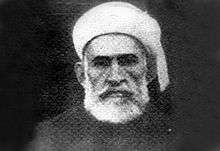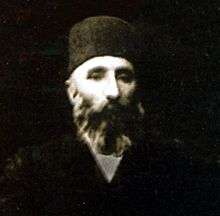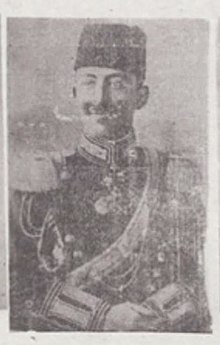Society for the Elevation of Kurdistan
The Society for the Elevation of Kurdistan "Kürdistan Teali Cemiyeti"[1] was secretly established in Constantinople on 6th November 1917[2], and officially declared on the 17th of December 1918[2], after the armistice of Murdos[3] and subsequent arrival of allied troops in the capital.[4]
It was the first re-establishment[5] of The Kurd Society for Cooperation and Progress of 1908.[6] This society like its predecessor has been known by an array of different names including, Society for the Advancement of Kurdistan[6], Society for the Rise of Kurdistan[7], Society for the Ascension of Kurdistan[8], Society for the Recovery of Kurdistan[9], Society for the Progress of Kurdistan[5], Kurdish Social League[10], Society for the Development of Kurdistan[11] and Society for the Betterment of Kurdistan.[12]
The charter of the society describes its mission as to protect the Kurd nation's political, economic and social interests and historical and racial rights.[13] It also called for the international recognition of Kurd rights[14], it rapidly gained widespread membership in its newly opened chapters.[14]
The leadership of the society was almost identical to that of its predecessor a decade earlier, including both Abdulkadir Ubeydullah[9] and Emin-Ali[9], but as its original third founder Serif Pasa was in exile, his replacement and representative was his brother Fuad Pasa.[9]
The leadership structure of the society;
President: Abdulkadir Ubeydullah[2]



Vice President: Fuad Pasha[2]
Secretary General: Hamdi Pasha[2]
Treasurer: Abdullah Effendi[2]
In January 1919 the society in a letter outlined its objectives to the British government through their High Commissioner in Constantinople Sir Somerset Gough-Calthorpe the letter consisted of four main points;
1. A specified and geographically defined territorial area to be assigned to the Kurds.[13]
2. The Kurds would be grateful to enjoy the same privileges and to receive the same treatment at the hands of the Allied Powers of the Entente, as those granted to the Arabs, Armenians, Chaldeans, Assyrians and other small nationalities without distinction of race and religion.[13]
3. The Kurds should be granted self government.[13]
4. The Kurds particularly beg the British government to kindly undertake the protection of their rights and interests, and to help them in their path to civilisation and progress.[13]
In June 1919 at its annual conference, the society voted to place the Wilsonian Fourteen Points at the centre of its political programme, and warned that if Kurds were to fail in securing their national rights, they would remain oppressed and deprived of rights, and possibly remain imprisoned for centuries.[13] The conference also declared the Kurds had the right to choose their own form of administration in their homeland and that it was appropriate for them to work towards attaining their national rights as did other nations and neighbouring communities.[13]
The society in a meeting at their Constantinople headquarters unanimously passed a proposal from their members that Serif Pasa be appointed as the sole representative of the Kurdish nation to the Paris Peace Conference in 1919.[15]
It published a journal called Jin (Life).[16]
Other notable members of the society numbered 176 in total.[2] They included Mevlanzade Rifat Bey, Mustafa Yamulki.
Membership to the society was not limited to Kurds. John Duncan (British Army officer) noted that the statutes of the society included "To be admitted, prospective members were to provide a recommendation from one of the established members."[17]
References
- Bocheńska, Joanna (2018). Rediscovering Kurdistan’s Cultures and Identities: The Call of the Cricket. Springer. p. 109. ISBN 3319930885.
- Ozoglu, Hakan (2004). Kurdish Notables and the Ottoman State: Evolving Identities, Competing Loyalties, and Shifting Boundaries. SUNY Press. p. 147. ISBN 0791459934.
- Olson, Robert. The Emergence of Kurdish Nationalism and the Sheikh Said Rebellion, 1880–1925. University of Texas Press. p. 27. ISBN 029276412X.
- Kedourie, Sylvia (2000). Seventy-five Years of the Turkish Republic. Psychology Press. p. 5. ISBN 0714650420.
- Kirisci & Winrow, Kemal & Gareth (2013). The Kurdish Question and Turkey: An Example of a Trans-state Ethnic Conflict. Routledge. p. 81. ISBN 113521770X.
- Schumann, Christoph (2008). Liberal Thought in the Eastern Mediterranean: Late 19th Century Until the 1960s. BRILL. p. 186. ISBN 9004165487.
- Stansfield & Shareef, Gareth & Mohammed (2017). The Kurdish Question Revisited. Oxford University Press. p. 78. ISBN 0190687177.
- Fosse & Fox, Marit & John (2015). Nansen: Explorer and Humanitarian. Rowman & Littlefield. p. 81. ISBN 0761865799.
- Chaliand, Gérard (1993). A People Without a Country: The Kurds and Kurdistan. Zed Books. p. 32. ISBN 1856491943.
- Bedr Kahn, Sureya (1995). The Case of Kurdistan Against Turkey. Sara. p. 19.
- Howard, Harry Nicholas (1963). An American Inquiry in the Middle East: The King-Crane Commission. Khayats. p. 288.
- Maisel, Sebastian (2018). The Kurds: An Encyclopedia of Life, Culture, and Society. ABC-CLIO. p. 16. ISBN 1440842574.
- Güneş, Murat Tezcür (2020). A Century of Kurdish Politics: Citizenship, Statehood and Diplomacy. Routledge. p. 16. ISBN 1000008444.
- Gingeras, Ryan (2019). Eternal Dawn: Turkey in the Age of Atatürk. Oxford University Press. p. 329. ISBN 0192508725.
- Theolin, Sture (2000). The Swedish Palace in Istanbul: A Thousand Years of Cooperation Between Turkey and Sweden. YKY. p. 114. ISBN 9750802586.
- Gunes & Zeydanlioglu, Cengiz & Welat (2013). The Kurdish Question in Turkey: New Perspectives on Violence, Representation and Reconciliation. Routledge. p. 73. ISBN 1135140634.
- Henning, Barbara (2018). Narratives of the History of the Ottoman-Kurdish Bedirhani Family in Imperial and Post-Imperial Contexts: Continuities and Changes. University of Bamberg Press. p. 416. ISBN 3863095510.